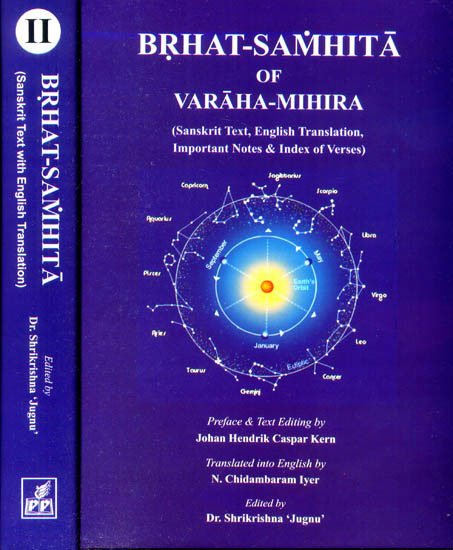Brihat Samhita
by N. Chidambaram Iyer | 1884 | 135,584 words | ISBN-13: 9788171104215
This page describes entry into the forest (vanasampravesha or vanapravesha) which is the fifty-ninth Chapter of the English translation of the Brihat-samhita. This work, written by Varahamihira in the 6th century, is classified as jyotisha literature, also known as Indian astronomy. It contains however, also content regarding astrology, palmistry, agriculture, gardening, perfumes, medicines and various other encyclopedic topics.
Chapter 59 - On entry into the forest (vanasampraveśa or vanapraveśa)
[Sanskrit text for this chapter is available]
Note: This chapters deals with the entry into the forest for the purpose of cutting wood for the images of the Devas.
1. On an auspicious day selected by the astrologer and suited to the master, when the several indications referred to in my work on Yātrā are all good, the party shall leave for the forest.
2. They shall not cut trees that grow on cremation ground, in roads, in temples, ant-hills, flower gardens, the abodes of religious devotees, places of worship, junctions of rivers as well as trees grown by human labour.
3. They shall not cut trees that are bent, that are covered with creepers or struck down by lightning or broken by the wind, or that have fallen of themselves or that are broken by elephants or that have dried or have been burnt or that contain the bee-hive.
4. The trees that are of glossy leaves, flowers and fruits, are fit for the purpose; the tree selected shall be adorned with flowers and duly honoured.
5. If the master is a Brāhmaṇa, the trees Devadāru, Sandal, Śamī and Madhūka are fit for the purpose. If the master is a Kṣatriya, the trees Margosa, Aśvattha, Khadira and Bilva are fit for the purpose.
6. If the master is a Vaiśya, the trees Jīvaka, Khadira, Sindhuka and Syandana should be selected for the purpose; and if the master is a Śūdra, the trees Tinduka, Kesara, Sarja and Aṛjuna should be selected.
7. In the formation of the Liṅga or an image, the sides of the tree as it grew shall be preserved; for this purpose the sides as well as the bottom and the top shall be marked before cutting.
8. The tree to be cut shall first be worshipped with rice cooked in milk, sweet-meat balls rice, curdled milk and sweet-meats made of ground sesamum and sugar and the like, liquor, flowers, scented smoke and sandal paste.
9. Then shall be worshipped at night the Devas, the Pitṛs, the Piśācas, the Rākṣasas, the Nāgas, the Asuras, the Gaṇadevas. Vināyaka and others. The tree shall be touched by the hand and the following mantras shall be pronounced.
10-11. “O tree! You have been selected for the image of such and such a Deva. Salutation to you. I request you to accept the pūjā duly performed by me. The Bhūtas that might dwell in this tree are requested to accept the presents offered and depart and dwell in some other place. Kindly bear the troubles we subject you to. Salutation to you.”
12. Early next morning water shall be poured over the root of the tree; the axe shall be rubbed over with honey and ghee, and the tree shall first be cut on the north-eastern side, and the other parts shall be cut round from left to right.
13. If the tree falls on the eastern, north-eastern or the northern side, it indicates prosperity. But if it falls on the remaining five sides—the south-east, the south, south-west, etc., there will respectively be fear from fire, suffering from hunger, disease, disease again, and the death of the horses.
14. Matters connected with the fall of the tree, the cutting of it, and with what might be inside the tree have been treated of by me in the chapter on Indra Dhvaja and on House-building. They apply here also.
